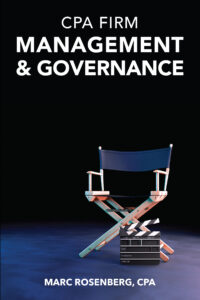3 Critical Upgrades for Your Firm’s Management
![]() Kristen Rampe, CPA / Oct 5, 2021
Kristen Rampe, CPA / Oct 5, 2021
It’s no secret that small to mid-sized CPA firms don’t have the same resources to manage their firms that the Top 100 do. Plus, smaller firm owners enjoy the freedom that comes with being able to do what they want and not be subject to corporate policies, red tape, bureaucracy, and other negative aspects of bigger businesses.
However, it’s fair to acknowledge that there is value in managing an accounting firm well, regardless of size. If you’re at a firm that could use an upgrade in management, the good news is that there are a few practices that you can adopt without losing the advantages of a $3-$30M firm.
- Hire a firm administrator. Yes, it’s money out of your pocket, and yes it will more than pay for itself. How? First off, more of your time can be spent on activities that only partners typically do. Bringing in new business, nurturing client relationships, mentoring the next generation of partners. Second, that time is either directly or indirectly revenue-generating. The last time I checked, reviewing your lease agreement, updating the insurance policy, and running payroll, while essential, were not quick to put dollars on your bottom line. But they are quick to reduce the time you have to add to your firm’s profitability.
- Hold more useful partner meetings. I come across firms that engage in three kinds of partner meetings:
- Value-add leadership sessions that are worthwhile for all attendees.
- Mediocre-at-best gatherings where agendas are scattered, long tangents are the norm, decisions are rare and follow-up is optional.
- No formal partner meetings, they simply catch one another in the hall/at their desk and deal with urgent matters as they arise.
What to do? First stop, if you are having partner meetings and they’re the bane of some/most partner’s existence, it’s time for an intervention. Be the leader who’s willing to point out how the meetings aren’t working as they should and offer to redesign. Second, if you’re not having any scheduled meetings, consider the value a well-run session will bring by allowing you to focus on the firm before issues arise. This may just reduce some of the fire-fighting mentality that plagues our industry.
Keys to holding a more useful partner meeting:
-
- Set a relevant agenda, with timeframes on each item. Consider standing agenda items, for example always checking in on the pipeline or recruiting efforts. Make sure that all partners need to be made aware of, or weigh in on, all agenda items. If not, hold separate smaller committee meetings to address those topics. This is how you keep the meeting useful for everyone.
- Determine who is best to keep the group on track with the agenda. This may not be your Managing Partner. Generally, if you need more time on a topic, table it for the next meeting or a separate discussion (and if appropriate with a smaller group – only those who need to weigh in).
- Be clear on the follow-up. Who will own what action items coming out of your meeting? Do you have a place to track partner to-do’s that give the group visibility into what’s been completed and what’s not? Additionally, the MP, Firm Administrator (that you hired per the recommendation above), or another responsible partner should follow up with each partner on their action items. Not to micro-manage, but to ensure the important partner-level work individuals agreed to do is getting done.
CPA Firm Management & Governance is a must-read for partners who want to run their firm like a real business. The book addresses ►Best Practices for managing and structuring the leadership group ►how decisions get made ►voting ►how the Board functions ►the role and expectation of a partner ►the Managing Partner ►organization structures for various firm sizes ►job descriptions of key management positions ►partner accountability and other issues.
- Set quarterly goals and check in on them (very briefly) each week. Taking a page from the Entrepreneurial Operating System (EOS) philosophy, the use of relevant quarterly goals that are aligned with your firm’s overall strategic direction can make a sizeable difference in reaching your annual goals. If you’re sick of floundering or putting the same initiatives on your radar year after year, only to have them continue to go nowhere, consider upgrading your goal setting (and accountability) approach.
Each partner should have 2 – 3 quarterly goals. These should be concrete items that you’ll be able to measure success or not at the end of the quarter. They should clearly contribute to the firm’s overall annual goals. E.g. if you have an annual goal to launch a new niche practice, one partner’s Q1 goals could be to (1) have conversations with five prospects in the new niche, and (2) launch the related website page. A second partner’s goals could be (1) interview three candidates to fill a manager position in the niche and (2) attend two related networking events.
Each week, partners share with each other whether they’re on track or off track on their individual goals. More lengthy discussions can take place when/where appropriate (hint: may not be the full partner meeting).
When firm management is a priority rather than an afterthought, partners feel better about the direction of the organization they helped create.
Ready to upgrade your firm’s management? Choose one of the three items above and make a decision on it at an upcoming partner meeting.

CPA Firm Management & Governance
Best practices for managing and structuring the leadership group; descriptions of both partnership and corporate styles; role of the managing partner and firm administrator; decision making; voting; the role of a partner and how the organization changes as the firm grows.
Learn More